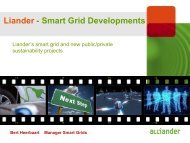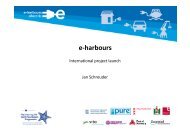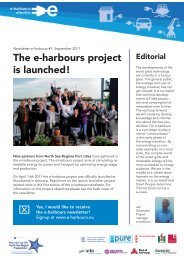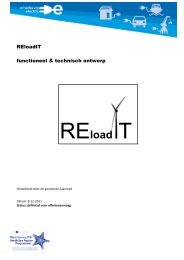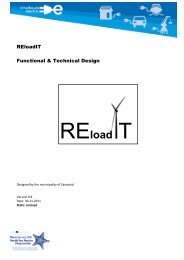renewable energy in zaanstad: from theory to practice - e-harbours
renewable energy in zaanstad: from theory to practice - e-harbours
renewable energy in zaanstad: from theory to practice - e-harbours
Create successful ePaper yourself
Turn your PDF publications into a flip-book with our unique Google optimized e-Paper software.
� Reduc<strong>in</strong>g <strong>energy</strong> consumption of exist<strong>in</strong>g houses with an<br />
<strong>in</strong>crease of two <strong>energy</strong> labels<br />
� Reduc<strong>in</strong>g <strong>energy</strong> consumption <strong>in</strong> <strong>in</strong>dustries by <strong>in</strong>creas<strong>in</strong>g the<br />
efficiency of processes<br />
These measures will lead <strong>to</strong> an extra reduction of 1.1 PJ/year <strong>in</strong> the <strong>energy</strong> demand. The estimated<br />
<strong>energy</strong> consumption <strong>in</strong> 2020 as results of this <strong>in</strong>tensive scenario will thus be 9.1 PJ/year. If Zaanstad<br />
wants <strong>to</strong> reach its objective of be<strong>in</strong>g CO2 neutral <strong>in</strong> 2020, it has <strong>to</strong> take every measure with<strong>in</strong> <strong>in</strong><br />
reach. That is why <strong>in</strong> the rema<strong>in</strong><strong>in</strong>g part of this <strong>in</strong>vestigation it will be assumed that the <strong>in</strong>tensive<br />
scenario will be accomplished and the <strong>energy</strong> consumption will drop <strong>to</strong> 9.1 PJ/year <strong>in</strong> 2020.<br />
3.3 BIOMASS<br />
Biomass is the most common form of susta<strong>in</strong>able <strong>energy</strong> worldwide and with 55 EJ 4 it accounted for<br />
15% of the worldwide primary <strong>energy</strong> supply <strong>in</strong> 2010 [4]. It is ma<strong>in</strong>ly used for cook<strong>in</strong>g and heat<strong>in</strong>g <strong>in</strong><br />
rural areas <strong>in</strong> develop<strong>in</strong>g countries, but it can also be converted <strong>in</strong><strong>to</strong> modern <strong>energy</strong> carriers such as<br />
gaseous fuels, liquid fuels and electricity. Biomass is a term for all organic material that is com<strong>in</strong>g<br />
<strong>from</strong> plants (<strong>in</strong>clud<strong>in</strong>g algae, trees and crops) and is produced <strong>in</strong> the process of pho<strong>to</strong>synthesis [6].<br />
Biomass can be considered as organic matter, <strong>in</strong> which the <strong>energy</strong> of sunlight is s<strong>to</strong>red <strong>in</strong> chemical<br />
bonds. When the bonds between carbon, hydrogen and oxygen molecules are broken by digestion,<br />
combustion, or decomposition, these substances release their s<strong>to</strong>red, chemical <strong>energy</strong> [6]. Biomass<br />
can be obta<strong>in</strong>ed <strong>from</strong> a wide range of resources such as waste streams, woody and grassy materials<br />
and all have different compositions and characteristics (moisture, ash etc.). There are three general<br />
conversion processes for biomass, i.e. thermochemical, chemical and biochemical conversion.<br />
Zaanstad has a relatively large biomass potential and is estimated at a <strong>to</strong>tal of 12.3 PJ/year. Research<br />
has shown that the most promis<strong>in</strong>g resources for biomass <strong>in</strong> Zaanstad are [1]:<br />
� Woody biomass (cacao shells, waste and sawdust) 1.6 PJ/year<br />
� Municipal waste 1.0 PJ/year<br />
� Waste <strong>from</strong> food <strong>in</strong>dustry 9.7 PJ/year<br />
Zaanstad has negotiated with different companies for a possible cooperation <strong>to</strong> <strong>in</strong>vest <strong>in</strong> a biomass<br />
power plant. Due <strong>to</strong> economic reasons and the fact that most of the resources have already other<br />
dest<strong>in</strong>ations, the negotiations have not yet resulted <strong>in</strong> collaboration.<br />
3.4 SOLAR ENERGY<br />
Pho<strong>to</strong> Voltaic<br />
Because of the large amount of R&D which is currently done <strong>in</strong> companies, <strong>in</strong>stitutions and<br />
universities, the efficiency of Pho<strong>to</strong> Voltaic (PV) cells are <strong>in</strong>creas<strong>in</strong>g and the production costs of PV<br />
4 EJ = Exa Joule = 10 18 J<br />
12<br />
0.4



